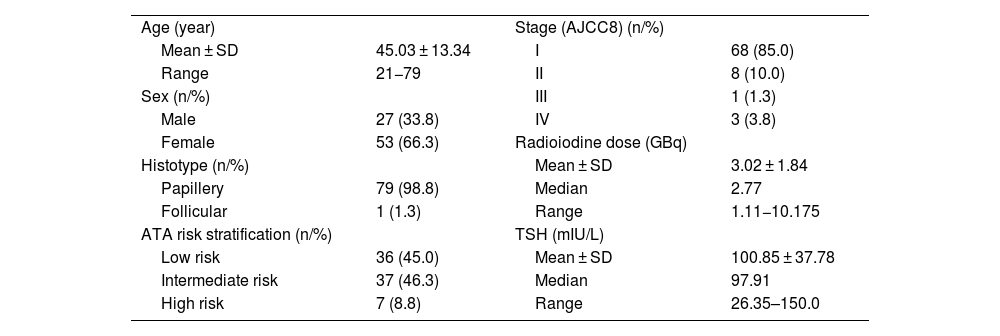Radioactive iodine therapy (RAIT) is recommended to reduce the risk of recurrence and metastasis in patients with intermediate-high risk differentiated thyroid cancer (DTC). In preparation for RAIT, stimulation of thyroid-stimulating hormone and reduction of body iodine pool are important for treatment success. For this purpose, patients are asked to reduce their iodine intake before RAIT, and the body iodine pool can be evaluated by measuring iodine excretion in urine before treatment. The aim of our study is to compare the methods used to measure the body iodine pool in the evaluation of the restricted iodine diet (RID) effectiveness applied in the RAIT preparation.
Patients and methodsEighty DTC patients discontinued levothyroxine three weeks before RAIT and followed up with a RID two weeks before treatment. After two weeks of RID, all patients collected their 24-h urine the day before the RAIT date. Patients completed 24-h urine samples on the morning of the RAIT date and also provided a spot urine sample. The estimated 24-h creatinine excretion of the patients was calculated. Estimated 24-h urinary iodine excretion (UIE) was calculated using the spot urine iodine/creatinine (I/C) ratio of the patients. 24-h UIE, iodine concentration in spot urine, I/C ratios in spot urine and estimated 24-h UIE of the patients were analyzed by comparing with each other.
ResultsIn 99% of the patients, RID efficiency was sufficient according to 24-h UIE before RAIT. The mean 24-h UIE was 48.81 micrograms/day (mcg/day) in 24-h urine samples taken from the patients to evaluate the body iodine pool. The patients' iodine concentrations in spot urine, I/C ratios in spot urine, and estimated 24-h UIE were all statistically significantly lower than actual 24-h UIE, which was the reference method (p: 0.026 vs <0.001 vs 0.041). Moderate positive correlation between 24-h UIE and iodine concentration in spot urine (r: 0.440), I/C ratio in spot urine (r: 0.493), and estimated 24-h UIE (r: 0.560) found. The strongest correlation was obtained with the estimated 24-h UIE.
ConclusionThe estimated 24-h UIE obtained by using the I/C ratio in spot urine can be used practically and safely as an alternative to UIE in 24-h urine, which is the gold standard method for evaluating body iodine pool.
El tratamiento con yodo radiactivo (RAIT por sus siglas en inglés) se recomienda para reducir el riesgo de recurrencia y de metástasis en pacientes con cáncer de tiroides diferenciado (CDT) de riesgo intermedio-alto. En la preparación para la RAIT, la estimulación de la tirotropina y la reducción en la reserva corporal de yodo son elementos importantes para contribuir al éxito del tratamiento. Para ello, se pide a los pacientes que reduzcan su ingesta de yodo antes de la RAIT, y puede evaluarse la reserva de yodo corporal midiendo la excreción de yodo por la orina (yoduria) antes del tratamiento. El objetivo de nuestro estudio ha sido comparar los métodos utilizados para medir la reserva de yodo corporal en la evaluación de la eficacia de la dieta con bajo contenido en yodo (RID por sus siglas en inglés) aplicada a la preparación del paciente para la RAIT.
Pacientes y métodosOchenta pacientes con CDT suspendieron la levotiroxina tres semanas antes de la RAIT y fueron controlados con una RID durante las dos semanas previas a la realización del tratamiento. Tras dos semanas de RID, en todos los pacientes se llevó a cabo una recolección de orina de 24h el día previo a la fecha de administración de la RAIT. Los pacientes finalizaron dicha recolección en la mañana de la fecha de RAIT y suministraron asimismo una muestra puntual de orina. Se calculó la excreción estimada de creatinina en orina de 24 horas de los pacientes. La estimación de la excreción urinaria de yodo o yoduria (UIE por sus siglas en inglés) de 24 horas se calculó a partir del índice yodo/creatinina (I/C) obtenido en la muestra de orina puntual de los pacientes. Se compararon los resultados obtenidos de la yoduria de 24 horas, la concentración de yodo en la muestra puntual de orina, el cociente I/C en la muestra puntual de orina y la estimación de la yoduria de 24 horas en los pacientes.
ResultadosEn el 99% de los pacientes, la eficacia de la RID fue suficiente según la yoduria de 24 horas obtenida previamente a la RAIT. La yoduria o UIE media de 24 horas fue de 48,81 microgramos/día (mcg/día) en las muestras de orina de 24 horas tomadas a los pacientes para evaluar su reserva corporal de yodo. Los valores de la concentración de yodo y el índice I/C, obtenidos ambos en la muestra puntual de orina de los pacientes, así como la yoduria estimada de 24 horas fueron todos ellos inferiores de forma estadísticamente significativa respecto a la yoduria real de 24 horas, que fue el método de referencia empleado (p: 0,026 vs. <0,001 vs. 0,041). Se detectó una correlación positiva moderada entre la yoduria de 24 horas y la concentración de yodo (r: 0,440), el índice I/C, ambos en la muestra de orina puntual (r: 0,493), y en la estimación de la yoduria de 24 horas (r: 0,560). La correlación más estrecha se obtuvo con la yoduria o UIE estimada de 24 horas.
ConclusiónLa estimación de la yoduria de 24 horas obtenida a partir del índice I/C obtenido en la muestra puntual de orina puede utilizarse de forma práctica y segura como alternativa a la determinación de la yoduria o UIE de 24 horas, que constituye el método de referencia para evaluar la reserva de yodo corporal.
Article

Revista Española de Medicina Nuclear e Imagen Molecular (English Edition)












